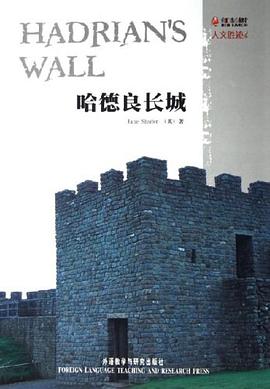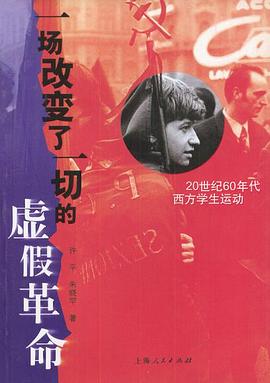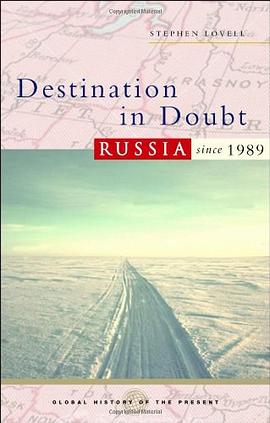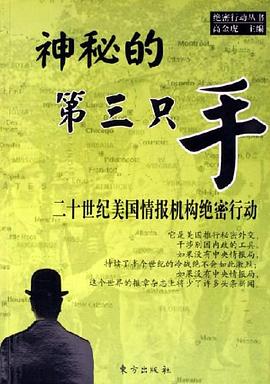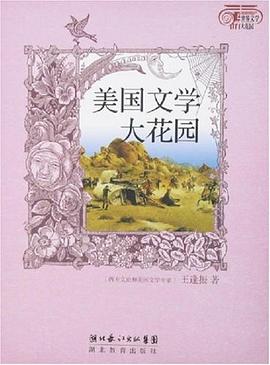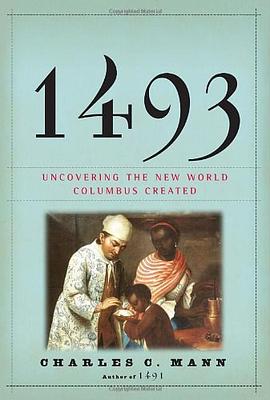

具体描述
Editorial Reviews
Amazon.com Review
Guest Reviewer: Nathaniel Philbrick on 1493 by Charles C. Mann
Nathaniel Philbrick is the author of the New York Times bestsellers The Last Stand; In the Heart of the Sea, which won the National Book Award; Sea of Glory, winner of the Theodore and Franklin D. Roosevelt Naval History Prize; and Mayflower, which was a finalist for the Pulitzer Prize in history and one of the New York Times' ten best books of the year. He has lived on Nantucket since 1986.
I’m a big fan of Charles Mann’s previous book 1491, in which he provides a sweeping and provocative examination of North and South America prior to the arrival of Christopher Columbus. It’s exhaustively researched but so wonderfully written that it’s anything but exhausting to read.
With his follow-up, 1493, Mann has taken it to a new, truly global level. Building on the groundbreaking work of Alfred Crosby (author of The Columbian Exchange and, I’m proud to say, a fellow Nantucketer), Mann has written nothing less than the story of our world: how a planet of what were once several autonomous continents is quickly becoming a single, “globalized” entity.
Mann not only talked to countless scientists and researchers; he visited the places he writes about, and as a consequence, the book has a marvelously wide-ranging yet personal feel as we follow Mann from one far-flung corner of the world to the next. And always, the prose is masterful. In telling the improbable story of how Spanish and Chinese cultures collided in the Philippines in the sixteenth century, he takes us to the island of Mindoro whose “southern coast consists of a number of small bays, one next to another like tooth marks in an apple.”
We learn how the spread of malaria, the potato, tobacco, guano, rubber plants, and sugar cane have disrupted and convulsed the planet and will continue to do so until we are finally living on one integrated or at least close-to-integrated Earth. Whether or not the human instigators of all this remarkable change will survive the process they helped to initiate more than five hundred years ago remains, Mann suggests in this monumental and revelatory book, an open question.
Timeline for 1493
200,000,000 B.C.: Geological forces begin to break up the world’s single giant continent, Pangaea, forever separating the hemispheres. After this, Eurasia and the Americas develop completely different suites of plants and animals.
1493 A.D.: Columbus sails on second voyage, establishing the first consequential European settlement in the Americas. Without intending to, he ends the long separation of the hemispheres—and sets off the ecological convulsion known as the Columbian Exchange.
1518: In the first environmental calamity of the modern era, accidentally imported African scale insects in Hispaniola lead to an explosion of fire ants. Spaniards flee the ant-infested island in droves; colonists in Santo Domingo hold procession in honor of St. Saturninus, praying for his aid against the insect plague.
1545: Spaniards discover the world’s biggest silver strike in Bolivia. In the next century, the world’s supply of this precious metal will more than double, giving Europe an economic edge that will help it colonize Africa, Asia and the Americas.
1549: Initial appearance of tobacco—the addictive American drug that becomes the first global commodity craze—in China. That same year, Hernán Cortés inaugurates the human part of the Columbian Exchange by signing the first contract to import large numbers of Africans to the American mainland.
1571: Miguel López de Legazpi colonizes Manila and establishes continual trade with China—Columbus’s life-long, never-fulfilled dream. Knitting the entire inhabited planet into a single web of trade, Legazpi’s actions are the beginning of today’s economic globalization.
~1615: Earthworms come to northern North America in English ship ballast. During the next three centuries, they will re-engineer forests from Ohio Valley to Hudson Bay.
1630-60: The gush of American silver finally causes its price to collapse, setting off a the world’s first global economic calamity.
1644: Collapse of Ming dynasty. Long struggle between remaining Ming in south and incoming Qing dynasty in north leads the latter to forcibly evacuate most of the southern coast; millions of dispossessed people pour into the mountains, where they grow maize and sweet potatoes, American crops first smuggled into China from Manila and other European bases.
1775: France’s Flour War, set off by high bread prices, persuades King Louis XVI to allow the pioneering nutritional chemist Antoine-Augustin Parmentier to stage a series of publicity stunts to persuade farmers to grow potatoes, a distrusted foreign species from Peru. Parmentier’s PR is so successful that broad swathes of northern Europe are soon covered with a monoculture of potatoes.
1781: Britain’s “southern strategy” pushes Gen. Cornwallis’s army into North America’s malaria zone, an area dominated by malaria parasites introduced from Europe and Africa. Defeated by malaria, the British army surrenders to a general it never fought: George Washington. This ends the Revolutionary War.
1845: Europe’s potato monoculture, which is unlike anything ever seen in Peru, turns out to be especially vulnerable to another Peruvian import, the potato blight. Ravaging the continent from Russia to Ireland, the blight causes a famine that kills an estimated two million people, half of them in Ireland.
~1867: Léopold Trouvelot, French amateur entomologist, smuggles gypsy moths to Medford, Mass., hoping to breed them with native silk-producing moths to produce a more robust silk-producer. Their almost immediate escape sets off an invasion that continues today. Trouvelot hurriedly returns to France before the dimensions of the problem can be known.
1880-1912: Industrializing nations, desperate for the elastic belts, pliable gaskets and the aborbent tires needed by steam engines and vehicles, buy every scrap of rubber they can get from the Amazon’s rubber trees, the sole source of high-quality latex. The ensuing rubber boom collapses after an Englishman smuggles rubber trees out of Brazil. Soon much of southeast Asia is covered with this foreign tree.
1979: The golden apple snail is sent from Brazil to Taiwan to launch an escargot industry there. It escapes, proliferates, and becomes a major menace to the island’s rice crop.
Review
“A muscular, densely documented follow-up [to Mann’s 1491] . . . Like its predecessor, 1493 runs to more than 400 pages, but it moves at a gallop . . . As a historian Mann should be admired not just for his broad scope and restless intelligence but for his biological senstivity. At every point of his tale he keeps foremost in his mind the effect of humans’ activities on the broader environment they inhabit.”
-Alfred W. Crosby, The Wall Street Journal
“In the wake of his groundbreaking book 1491 Charles Mann has once again produced a brilliant and riveting work that will forever change the way we see the world. Mann shows how the ecological collision of Europe and the Americas transformed virtually every aspect of human history. Beautifully written, and packed with startling research, 1493 is a monumental achievement."
-David Grann, author of The Lost City of Z
“Spirited . . . One thing is indisputable: Mann is definitely global in his outlook and tribal in his thinking . . . Mann’s taxonomy of the ecological, political, religious, economic, anthropological and mystical melds together in an intriguing whole cloth.”
-Jonathan E. Lazarus, The [Newark] Star-Ledger
“Fascinating . . . Convincing . . . A spellbinding account of how an unplanned collision of unfamiliar animals, vegetables, minerals and diseases produced unforeseen wealth, misery, social upheaval and the modern world.”
-Starred review, Kirkus
“A landmark book . . . Entrancingly provocative, 1493 bristles with illuminations, insights and surprises.”
-John McFarland, Shelf Awareness
“A fascinating survey . . . A lucid historical panorama that’s studded with entertaining studies of Chinese pirate fleets, courtly tobacco rituals, and the bloody feud between Jamestown colonists and the Indians who fed and fought them, to name a few. Brilliantly assembling colorful details into big-picture insights, Mann’s fresh challenge to Eurocentric histories puts interdependence at the origin of modernity.”
-Starred review, Publishers Weekly
“In 1491 Charles Mann brilliantly described the Americas on the eve of Columbus’s voyage. Now in 1493 he tells how the world was changed forever by the movement of foods, metals, plants, people and diseases between the ‘New World’ and both Europe and China. His book is readable and well-written, based on his usual broad research, travels and interviews. A fascinating and important topic, admirably told.”
-John Hemming, author of Tree of Rivers
“Fascinating . . . Engaging and well-written . . . Information and insight abound on every page. This dazzling display of erudition, theory and insight will help readers to view history in a fresh way.”
-Roger Bishop, BookPage
“Charles Mann expertly shows how the complex, interconnected ecological and economic consequences of the European discovery of the Americas shaped many unexpected aspects of the modern world. This is an example of the best kind of history book: one that changes the way you look at the world, even as it informs and entertains.”
-Tom Standage, author of A History of the World in Six Glasses
作者简介
查尔斯·曼恩是《大西洋月刊》《科学》和《连线》杂志的撰稿人。他也为《财富》杂志、《纽约时报》《史密森尼》《名利场》《华盛顿邮报》供过稿,曾三次进入美国国家杂志奖决赛的作者,被美国律师协会、美国物理研究会、阿尔弗雷德·P·斯隆基金会和兰南基金会授予过与写作相关的奖项。他的著作《1491》赢得了美国国家学院传播奖的年度最佳图书奖。
目录信息
读后感
上世纪七十年代,一位美国的乡村民谣歌手在一首歌里唱到:“西弗吉尼亚,如天堂一般,那有蓝岭山脉,谢南多亚河,生命在那里比树木更长久……”他对弗吉尼亚这片土地是如此热爱,因此必须在他的唱片中强烈讴歌——但倘若让他回到差不多五百年前的这片土地,那么他彼时的感受或...
评分感谢古巴比伦人发明、犹太人传到埃及、进而被欧洲人发扬光大的星期制,让我在这个七天小周期的最后一天和第一天可以安心宅在家,穿着极有可能来自中东的石油加工而成的聚酯纤维材料制成、在中国裁剪加工、却贴着日本时尚快消品牌的居家服,葛优躺在沙发里。 我拿起美国设计、...
评分 评分关键点:物种大交换的影响 复述知识 1.本书就想告诉我们一句话——物种对历史的影响巨大,甚至会左右我们人类历史的发展进程。 2.案例1,中美洲的烟草来到北美,烟草贸易成为经济支柱。英国的蚯蚓来到美洲,改造了美洲土地肥力。 3.案例2,疟疾病来到美洲,通过蚊子大范围传...
评分越来越多的学者相信由哥伦布航海引发的生态变化是现代世界标志性事件之一。为什么欧洲会崛起并主宰世界?为什么曾经最富有的、社会结构最先进的中国会一落千丈?为什么奴役制度在美洲能大行其道?为什么是在英国发生工业革命?所有这些疑问都以关键的方式与哥伦布交换相关联。 ...
用户评价
这书太娘们了,没有干货。
评分connected Columbus' explorations to the collapse of Ming dynasty. very intriguing. I like his way to light up the connections between events
评分connected Columbus' explorations to the collapse of Ming dynasty. very intriguing. I like his way to light up the connections between events
评分这书太娘们了,没有干货。
评分这书太娘们了,没有干货。
相关图书
本站所有内容均为互联网搜索引擎提供的公开搜索信息,本站不存储任何数据与内容,任何内容与数据均与本站无关,如有需要请联系相关搜索引擎包括但不限于百度,google,bing,sogou 等
© 2025 book.quotespace.org All Rights Reserved. 小美书屋 版权所有





